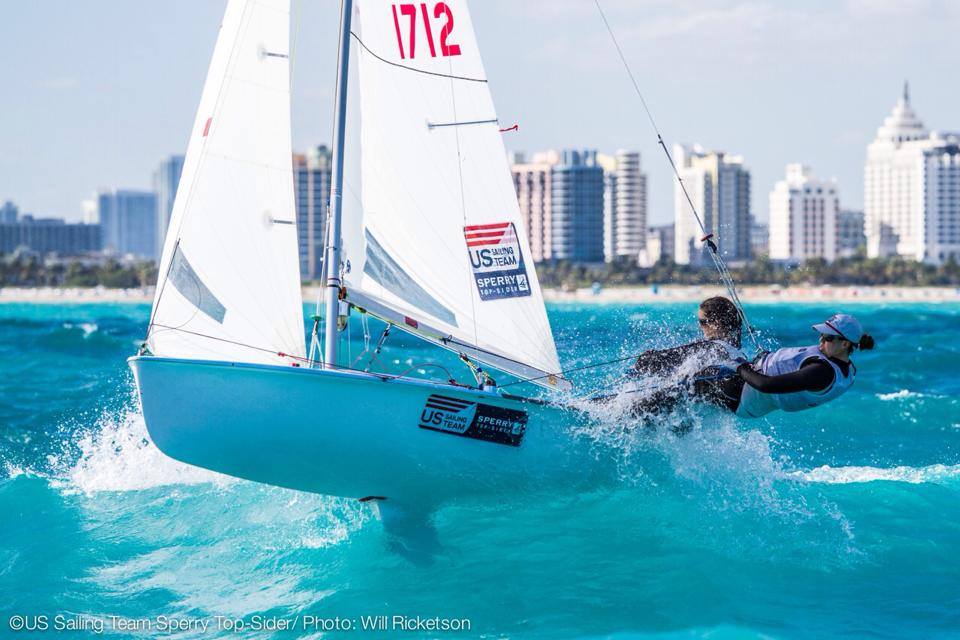
I never took notes when I was racing Lasers, because the boat was more about feel and being present in the moment. When I moved to the 470, however, that quickly changed. The 470 is such a technical boat, and having spent most of my earlier years in Optis, Lasers and collegiate boats, I was concerned with the level of detail that it demands. I remember when my crew, Briana Provancha, introduced me to the boat over Thanksgiving break in 2010, and how I even ended up taking notes on how to rig the boat because it was such a foreign concept.
A lot has happened since 2010. Briana and I have steadily climbed the Olympic 470 ranks, winning gold at the final Olympic test event. Our success has been due to many factors, but one of the most important has been our ability to keep track of all the details. We are both constantly writing things down. As an indicator of how much there is to learn and keep track of, so far in this campaign, I’ve filled six spiral notebooks.
At first I tried to fit all my notebooks in one binder, but there was so much information, I had trouble extracting anything from it. So now, as soon as I’ve finished with a notebook, I’ll go through and highlight important things, and then I put it aside. Otherwise, I get bogged down with all the information.
I keep only the two most recent notebooks in a binder that travels with me to all regattas. These are sort of the “greatest hits” of my earlier notebooks, as they include just the key points I thought I would need in the future. My first notebook, for instance, has information about rigging a 470 that’s not included in my binder. Hopefully I’m now past that point on the 470, but I do occasionally go back to those earlier notebooks; I still find good reminders in them of what I should be doing or how I should be tuning the boat.
When I’m at a regatta, I’ll take time at the end of each day to write in my notebook. I tend to take more notes about what has gone poorly rather than what has gone well, but that probably just reflects one of my personality traits. At the time, focusing on what didn’t go well is probably not the best thing to do, but it’s nice to go back to it later and say, “Yeah, that makes a lot of sense.”
I suppose there’s also a bit of psychological advantage here as well. There have been days when reviewing past errors helps me move on. It’s like a reset button. You dump it all out there on paper: This is what we did great, this is what we did poorly. But then you have to think, “OK, let’s get ready for the next day.”
At the end of a regatta, after I’ve had time to decompress, I’ll go through and read the notes carefully, and then I’ll put them away for a long time. I’ll go back to what I’ve written as soon as the notebook is completely done. I’m also careful to take notes at our debriefing sessions with our coach, Dave Ullman. I try to take away one major concept from each session, since there is often a lot of information to digest. I’ll highlight or star that one major point so when I’m looking through the notes later on, reading everything will not seem like a major undertaking.
I organize my notebook in three sections: setup, tactics and technique. The technique section has to do with things like steering through shifts, or sailing upwind and downwind. I color-code a lot of my notes to make things easier to find: The more technical, nitty-gritty numbers are in red, and the technique stuff is in green and purple. I’ll also highlight things that I find super interesting. Within the three sections, I find it’s easier to filter information if you keep it in an outline format, rather than as a bunch of thoughts or bullet points.
I also keep the number of words to a minimum and even use little shorthand phrases so excess words don’t bog me down, and I include diagrams. When I look back, that’s what often catches my attention. For instance, if you look in my notebook, you’ll see a diagram from a race in the 2013 Europeans of a tactical situation that shows the downwind tactics of jibing to put boats in the bank if it’s a long, persistent shift. Having this diagram really helps me keep that situation in mind. If I discover the same thing happening on the racecourse, I often think, “Oh, my notebook — I remember this happening.” It’s almost like a flashbulb memory going off. You’ll also find diagrams relating to sail shape in my notebooks.
While my handwritten setup section deals with things that generally don’t change, such as the mast-butt position or how long the mainsheet bridle is, there are always notes to take on the newest and greatest ideas for tuning. I keep those on my computer, which makes them easier to update. From there, I can print out and laminate a copy of the tuning guide we’ve developed, and bring it with us on the boat.
While feeling what the boat needs is natural for me, having notes available to study keeps me from getting stuck and overwhelmed by all the controls in high-stress racing situations. It’s interesting how, when Briana and I set out on this journey, everyone told us that we would have to become students of the sport. They were right. Taking notes fast-tracked our learning.









